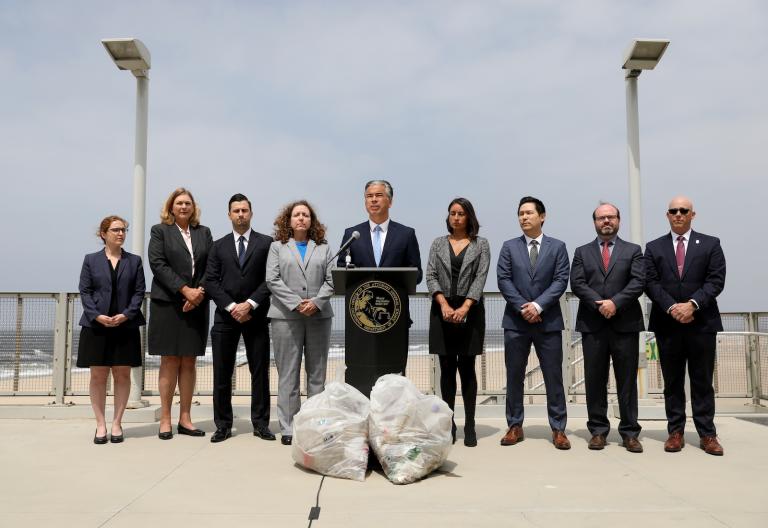Ron DeSantis, the Florida governor who hopes to coast to reelection on Tuesday, has been touted as the future of the Republican Party. This is not only because of his hardline stances on immigration and COVID restrictions, which have made him the most obvious potential challenger to Donald Trump for the next GOP presidential nomination, but also because of his proactive approach to climate change.
DeSantis’ distinctly conservative approach to climate policy prioritizes adaptation measures like sea walls and big-ticket infrastructure projects over reducing the carbon emissions that cause global warming in the first place. His Resilient Florida program is distributing hundreds of millions of dollars in adaptation funds to Florida communities threatened by severe weather and flooding, all while studiously avoiding the term “climate change.”
There is one constituency, however, that the presidential hopeful has ignored entirely when it comes to preparing for climate change: the more than 80,000 Floridians who are incarcerated in state prisons.
Even as neighboring Republican-led states have taken steps to reform or modernize their prison systems — steps as basic as installing air conditioning — Florida remains distinct among its peers for its harsh sentencing laws and lack of measures protecting the incarcerated from extreme heat. In fact, public records obtained by Grist suggest that Florida lacks any comprehensive policy at all to safeguard the health of people locked in prisons without air conditioning, who are disproportionately Black and increasingly elderly. These vulnerabilities are compounded by the difficulty of staffing these sweltering facilities: About a quarter of Florida Department of Corrections staff positions are vacant, following years of budget cuts.
Around the time DeSantis was signing off on more than $1 million to fund plane flights delivering asylum seekers to the home states of Democratic party leaders, a prison crisis in his own state was boiling over. In September, DeSantis called on the National Guard to send personnel to nine prisons in an attempt to staunch “severe staffing shortages at certain institutions that, if not addressed immediately, could jeopardize public peace and domestic security.”
Although DeSantis approved funding to increase corrections officers’ entry-level salaries from $33,500 to $41,600 earlier this year, he declined to support recent bills aimed at underlying problems in the prison system. State legislators, including some reform-minded Republicans, introduced several measures intended to reduce sentences and bring down prison populations, but all major reform proposals failed. Both Republican-led branches of the legislature did, however, pass $840 million in funding for a new, 4,500-bed air-conditioned mega-prison and prison hospital — a solution that many reform advocates saw as a poor substitute for imprisoning fewer people in the first place. DeSantis vetoed even that.
Less than a quarter of Florida state prison housing units — 157 out of 639 dormitories — have air conditioning, according to Department of Corrections Deputy Communications Director Molly Best. At least 53 of Florida’s 73 state prisons have no air-conditioned housing at all.*
Air conditioning can mean the difference between life and death in prison, according to a new study published on Wednesday in the journal JAMA Network Open. Researchers examined increases in prisoner mortality rates on days of extreme heat in Texas. They found that heat was associated with an average of 14 deaths per year in the state’s unairconditioned prisons between 2001 and 2019. In prisons with air conditioning, there was no correlation between hot days and death. No similar study has been conducted in Florida.
“Governor DeSantis sails in on this tough-on-crime stance, and that’s all well and good, but they put people in these horrible conditions and some of them don’t get out,” said Gail Snyder, whose brother is serving a 36-month sentence for breaking his probation and stealing groceries from the self-checkout register at a Walmart. He is 64 and diabetic, a condition associated with heat sensitivity, and he passed out repeatedly from the heat this summer. Snyder told Grist that she spent months wondering, “Is my brother going to end up with basically a life sentence for $178 at Walmart?”
Florida’s prison woes have been exacerbated by its sentencing laws. The state abolished parole in 1983 and later passed a law that encouraged prosecutors to seek maximum sentences for formerly incarcerated people who commit a new felony within three years of their release. Such laws mean that Florida has significantly more people serving life sentences without parole than any other state. It is also the state with the highest proportion of so-called “elderly prisoners” over age 50, who are particularly vulnerable to heat.
Without a major intervention, Florida’s prison population is poised to become markedly more vulnerable in the years ahead. The proportion of Florida prisoners over age 50 is expected to grow from 28 to 34 percent by 2026. This rapid aging is occurring as climate change is making extreme heat more frequent and severe. By mid-century, it’s likely that every state prison in Florida will be in a county with over 20 days annually where the heat index rises above 105 degrees Fahrenheit, according to a Grist analysis of data from the Union of Concerned Scientists. By the end of the century, a quarter of Florida prisons will likely see over 50 days annually above 105 degrees, according to an investigation by The Intercept.
Other states have faced multimillion-dollar lawsuits arguing that a lack of climate control in hot prisons constitutes a violation of the Americans with Disabilities Act or the U.S. Constitution’s prohibition of cruel and unusual punishment. Such suits forced Texas to establish an elaborate system to monitor heat in unairconditioned prisons and provide air-conditioned housing to people who are heat-sensitive. Although some researchers have found these policies insufficient, they are more thorough than anything Florida is doing.
The Florida Department of Corrections appears to have few protocols in place to protect prisoners with health conditions that make them vulnerable to heat. In response to a public records request for any and all Florida Department of Corrections heat policies, the agency shared only facility maintenance plans and first aid information, including a PowerPoint presentation that dedicates as much space to snake bites as heat. One slide describes the difference between heat exhaustion and heat stroke, and another provides instructions for responding to heat-related emergencies. A separate fact sheet defines types of heat stress and how to treat them.
The agency also shared a consent form for antipsychotic medication, which notes, “Avoid too much exercise, extreme heat, or other activities that are likely to dehydrate you unless you are able to get enough water.”
Asked how a patient taking such medications would avoid heat while incarcerated, spokesperson Best said in an email that each new prisoner takes an intake exam when they are first incarcerated and is continuously monitored for medical needs.
“The Florida Department of Corrections has air-conditioned housing units which serve the most vulnerable inmate populations such as the infirmed, mentally ill, pregnant and geriatric,” she stated, adding that dorms without air conditioning do have fans or exhaust systems as well as refrigerated water fountains. “General population inmates have access to air-conditioning in buildings designated for chapel, programs, classification, medical and administration.”
“Ensuring inmates incarcerated in Florida’s prisons receive medical and behavioral treatment is one of [the Florida Department of Corrections’] core constitutional responsibilities,” Best said.
Nevertheless, Florida does not appear to be tracking extreme heat and its impact on prisoners. Asked for recent temperature records, Best replied, “The department does not keep any type of log for ambient internal or external air temperatures at any of the Florida correctional institutions.” As for how many people have died of heat-related illnesses over the past decade, Best demurred, stating that only the medical examiner could share information about causes of death. “[The department] does not track heat related illnesses,” she said.
The heat issue is one that the loved ones of incarcerated people have increasingly organized around, working with prisoner advocacy groups like Florida Cares. The organization periodically holds Beat the Heat Challenges, where policymakers are asked to spend three minutes sitting inside a replica of a prison cell without air conditioning. They say the combination of harsh sentencing and extreme heat is causing illness and death that could easily be prevented.
When Donna Muller lost her brother to suicide in August 2021, while he was incarcerated, her thoughts turned quickly to the heat. Two weeks before he died, 48-year-old John Crimins had sent his sister an email from the Lake Correctional Institution, a mostly unairconditioned prison located in a county that averages 123 days annually where the heat index surpasses 90 degrees Fahrenheit.
“Hey sis sorry I haven’t been much on communication recently. This time of year is always rough,” he wrote. “The heat is just oppressive to the point of despair. Crazy thoughts you know.” By late afternoon on the day Crimins died, the heat index outside hit 105 degrees.
Muller knows it would be an oversimplification to claim heat was all that led to her brother’s death. Crimins, a father of three, was serving a life sentence on an attempted murder charge for an incident he described as self-defense, and he had struggled on and off with depression throughout his life. However, she feels strongly that the heat made the situation less tolerable. (Spokesperson Best said that privacy laws prevent the Florida Department of Corrections from commenting on any individual’s physical or mental health.)
“The sentence did not even come close to fitting the crime,” Muller said. “Families are just holding their breath, waiting for legislation in the hopes that their loved ones will get out.”
* Grist determined the number of detention facilities with no air conditioning by comparing an online directory of Florida Department of Corrections “major institutions” with a list of air conditioned facilities provided by Deputy Communications Director Molly Best. Grist’s estimate counts prison annexes and affiliated units (such as Apalachee Correctional Institution, East) as individual prisons. Grist’s estimate does not include re-entry centers, work camps, or community release centers. The full list of facilities with air conditioning can be found here.




